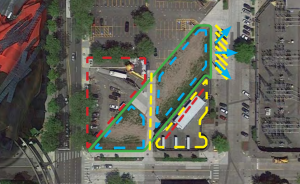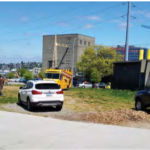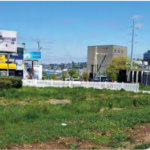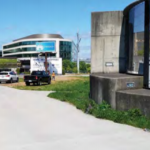SeaSk8 Upd8: Site selection narrowed

The site selection process for the SeaSk8 replacement has hit a meaningful milestone this week.
Grindline was hired by the City of Seattle to perform a feasibility study on three preferred sites: Lake Union Park, an area of grass on Broad Street adjacent to the EMP and Space Needle, and a parcel of land owned by Seattle Department of Transportation tucked between some parking lots, the Ride The Ducks operation, and a power substation that we’ll refer to as the “SDOT ROW Site”.
After reviewing the report, the skatepark advocates at the table agreed that the SDOT ROW Site is the preferred site for multiple reasons which are unfortunately that it doesn’t suffer from as many challenges as the others when it comes to skatepark placement. Of the three sites, the ROW site is actually the least appealing from an environmental standpoint. It’s tucked away, unappealing on it’s own, and surrounded by noise and traffic. The future of the site involves development on two of the four surrounding sides, which means that all site lines will terminate at building walls. But as beautiful as it is, Lake Union Park is a potential liquefaction nightmare, and the Broad Street site is also very nice, but the shape would really constrain the design of the skatepark. Both of those sites also have other issues that you can read about in the report.
The SDOT ROW Site has some key strengths. It’s a large contiguous space that can support a wide variety of design options. It has the most potential for a roof, which is the #1 thing we are hearing from people that we desperately need. There aren’t a lot of other things it can be used for and the City wants to activate the space. It may not be the crown jewel of city properties, but as a love match for a skatepark at this time in Seattle’s history, it’s a pretty solid choice. However, it does have some issues which we have enumerated in a letter to the engaged parties for their consideration:
- Safety: we understand the existing alley easement that bifurcates the potential skatepark footprint needs to be maintained following construction of the skatepark.  The potential for vehicles to transit across a portion of the skatepark creates a significant safety issue.  The skatepark design should include a means to mitigate for this safety hazard and include input from Skate Like a Girl that will be host trainings for inexperienced, young skateboarders that present a unique safety hazard.  We also recommend the skatepark design team directly account for potential hazards associated with the adjacent power station.
- Permanence: this is the 5th iteration of this skatepark to be built and it is concerning to us that when it is demolished in October of next year, the current park will be 10 years old, which also happens to be the suggested length of the term lease. Based on past experience, it’s not unrealistic to imagine that in another 10 years we could be back at the table working on SeaSk8 6. We feel that skateparks are facilities with much longer lifespans and that the City of Seattle should be getting more value out of it’s skatepark investments. With all of the future development anticipated in the surrounding area, we feel that this skatepark could be at exceptional risk in the near future and deserves an extraordinary commitment by the City of Seattle to protect it. Therefore, we are recommending that the Seattle City Council extend the term lease initial period from the typical 10 years to 20 years, with unlimited 10 year renewal periods after that. This would double the initial period, and provide the skateboarding community some added assurance that the city is committed to the skateboarding community, and this facility.
- Size: the skatepark footprint should encompass the entire approximately 19,000 square feet evaluated in the “Seattle Center Skatepark Relocation Feasibility Studyâ€, including the alley easement.  This will allow the skatepark design to include a larger range of features and better “flow†of skateboarders to minimize chances for collisions.
- Noise: we understand the property surrounding the potential skatepark footprint has been zoned for 15 story residential buildings.  It will therefore be very important to include noise attenuation in the skatepark design.  The most effective means of attenuation for vertical noise migration will be the installation of a cover over the skatepark and we highly recommend this be included in the initial design.  This cover could also function to provide shelter from rainfall and a platform for lights, both of which will drastically increase use of the skatepark during the dark, wet winter months.
- Lighting: we recommend the design include the installation of lights.  This will drastically increase the use of the skatepark during the dark winter months, serve to decrease vandalism, and generally increase user and bystander safety.  Skatepark lighting has seen significant improvements in the last several years so it is important the design consultant include a lighting expert on their team.  Poor lighting presents a safety hazard.
- Drinking Water: due to the sites location and surrounding buildings, a source of potable drinking water is anticipated to be located in close proximity to the site.  It is important to provide drinking water to skateboarders given the strenuous activity and a water source will further minimize trash in the form of plastic water bottles.
- Integration of Art: we recommend the art installations at the current SeaSk8 skatepark be relocated in the replacement site, as well as incorporation of new art.
These concerns will shape the conversation moving forward as we work toward securing a commitment from the City on this site. It should be noted that the “term lease” referenced in item #2 is an agreement between SDOT and the City Council to shift “ownership” for the site away from SDOT to be used as a skatepark. (The current plan is that the Seattle Center would maintain the site.) The usual term lease is 10 years with 2 10 year extensions. We are asking for a longer initial term simply due to the fact that this skatepark has a history of being torn down and we feel like the skateboarders deserve an extraordinary commitment from the City this time around.
The next step will be when our concerns are presented to Council next Thursday in a briefing, and we hope to move to the design phase shortly after this site is agreed upon by all parties.



The SDOT location appears promising, but the right of way for the Ride the Ducks is a recipe for disaster. That company is dangerous and I see little hope for much beyond conflict between the skate community, their careless employees and the tourist crowd that keeps that firm in business. Even after the collision on Aurora Bridge a few years back (and more recently the vessel that sunk a few months ago in Missouri), Ride the Ducks disregard for safety is appalling (indeed, last year one of their vehicles came a few feet from hitting my six year old after it jumped onto the sidewalk while turning a corner). The sooner RtD is gone, the better.
I am really interested in learning about the skatepark design because the current SeaSkate is disappointing and, frankly, underutilized. And the amount of money spent on it was wasteful. With all the problems in this city, we cannot afford to waste any money on parks that don’t get used. If we mess this one up, then we have little chance of convincing the city to place skate spots/dots in more neighborhoods.
What Seattle truly needs is a street skatepark. The community does not need a bowl, as Delridge, Jefferson, Ballard, and Woodland Park has that covered. All those parks are easily accessible on bus routes, too, so there is very little to be gained from pouring money into another large bowl (and I say this as someone who loves skating transition).
The community needs a park unlike anything that exists in Seattle at the moment. We need a street skating spot with tons of room, some well chosen obstacles, and lighting. The design should take into account how people will actually use the space, rather than cramming as many elements as possible into a single space (which is more characteristic of nearly all Seattle skateparks). The Cap Hill tennis courts see far more skateboarders on a Friday night than many purpose built skateparks would see in a week, and it is a tennis court! The Seattle Center park needs a ledge, manny pad, bank, and a flat bar in 9,000 square foot area would ensure the park would actually get used. If it were covered, I doubt Seattle would have a more used recreational facility in city limits. A truly useful park will require rigorous discipline—it’s as important what you keep out as what you put in. I know Grindline can built a great bowl, I just don’t think we need another one.
Thanks for keeping the community informed. Keep up the good work.
As the father of a budding skateboarder, I’m greatful for all the hard work being done to ensure a replacement for Seask8. Thank you!